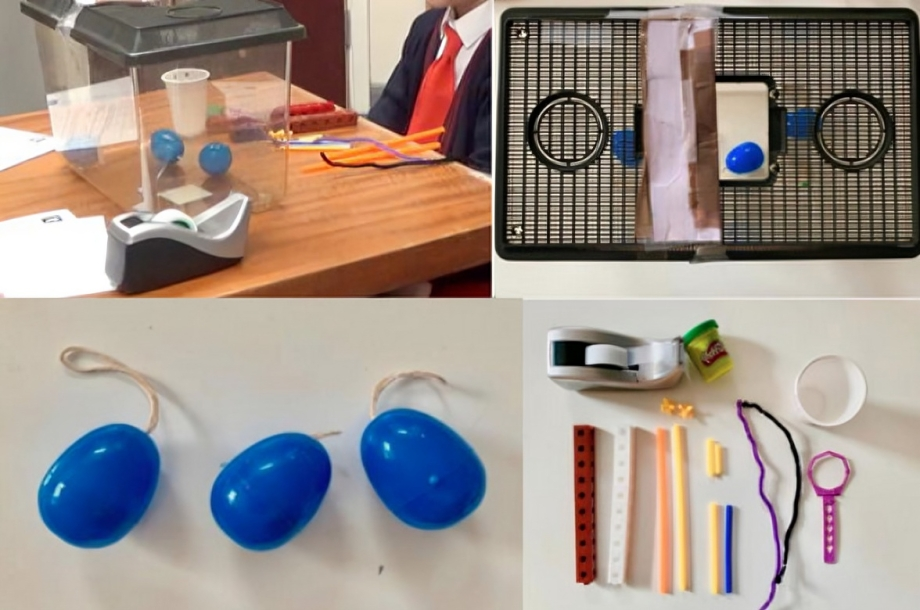By Faith Toreno
February 14, 2024
Cracking the Code: The Egg Heist
Ever wondered how kids think when faced with tricky challenges? A recent study in Developmental Psychology took a playful approach for an egg-citing experiment.

Set-up for “Egg Heist” experiment. Photos from ChiLD Lab.
Picture this: you’re 6 years old, seated in front of a clear box with three unattainable plastic eggs, each with a little sticker surprise inside. But here’s the twist. You can’t put your hands inside the box, making it impossible to simply reach in and grab the treasures. This is your mission and the clock is ticking!
In this pioneering experiment led by Emily Burdett and Samuel Ronfard, children were armed with various items. Tape, clay, pipe cleaners, blocks, straws and much more. Their mission? To retrieve these little eggs using whatever innovative means they could think of. With 10 minutes on the clock, the little scientists need to build a tool that can fit through the opening to get their treasures.
Now, 10 minutes is a long time compared to other studies that have only given children 1 minute. Dr. Ronfard explains that they give children more time to allow them to explore the different items. Imagine if you had to solve something with only one minute and only one solution. It wouldn’t show all the cool ideas you might have. They call this tinkering.
Tinkering, playing around with ideas and trying different things is the secret ingredient to cracking the code of creative problem-solving. Dr. Ronfard says: “Divergent thinking is thinking about multiple possibilities and focusing on multiple solutions. It is the ability for coming up with multiple uses which is helpful for solving things.” The researchers thought that this kind of thinking is key to successful problem-solving. And guess what? They seem to be right.
But is there an opposite to divergent thinking? Dr. Ronfard says yes! It’s called convergent thinking, where the focus is on narrowing down options to find the best solution. Both divergent and convergent thinking work hand in hand in problem-solving. Convergent thinking asks, “Out of all the creative ways divergent thinking came up with to solve this, which one is the best?”
So what’s the scoop? What happened during the Egg Heist? Dr. Ronfard tells us that successful Egg Heisters exhibited a common trait. More successful and older children would build a tool through multiple attempts. When faced with challenges, they would modify their approach, learn from their experiences, and then try the task again. The exciting part is that it really isn’t about age at all. What mattered was how many times they were willing to try different things. The Egg Heisters’ secret to success appears to be this: when facing a setback, they make smaller changes, keep more of what was working, and try more new things.
A recent discussion with Dr. Ronfard emphasizes the importance of divergent and convergent thinking. This perspective is crucial because it enables us to adapt and find solutions for a wide array of problems. Whether you’re a child or an adult, life presents us with diverse challenges, and there isn’t a one-size-fits-all for each one. Dr. Ronfard says: “As children go through life, we want to teach them how to solve new problems on their own. This requires them to be able to reflect on what the problem is, generate a lot of ideas on how to solve the problem, and identify the best way to solve the problem.”
Burdett and Ronfard’s “Egg Heist” experiment underscores the importance of both divergent and convergent thinking as the dynamic duo to become efficient problem-solvers. By providing challenges like their little egg-heist, we don’t just give kids a fun activity, we nurture skills they’ll use throughout their lives. According to Dr. Ronfard: “A lot of research in cognitive development shows that children learn a lot on their own, but children also learn a lot in conversation with others and by doing things with other people.” Dr. Ronfard also emphasizes the importance of allowing children the freedom to do things on their own and the freedom to make mistakes. He mentions: “Ask them (the children): Why do you think this didn’t work? What can we change?”, fostering their curious little minds to think critically and broadly.
Now this information isn’t just for scientists and researchers! Parents, teachers, and anyone who spends time with children can learn something egg-straordinary from this study. Instead of telling kids there’s only one right answer, give them tools and challenges like this experiment’s Egg Heist that let them try out different ideas.
According to Ronfard: “The more that children are exposed to problems, to solutions- the more we teach them about the world- the greater their ability to imagine new ways of solving things.” We ask Dr. Ronfard if it’s better to let children learn on their own through play or if we should help them step-by-step. He tells us that allowing children to do things on their own can be enjoyable, but it may limit their learning. In contrast, simply telling them without providing an opportunity for hands-on exploration with you might constrain their learning and the development of reflective skills. Dr. Ronfard says: “The best way really is to work alongside the child, let them lead, but ask them questions to help them reflect on the process, so they can refine their process and internalize this reflection as part of their problem solving behavior.”
Burdett, E., & Ronfard, S. (2023). Tinkering to innovation: How children refine tools over multiple attempts. Developmental Psychology, 59(6), 1006–1016. https://doi.org/10.1037/dev0001512
